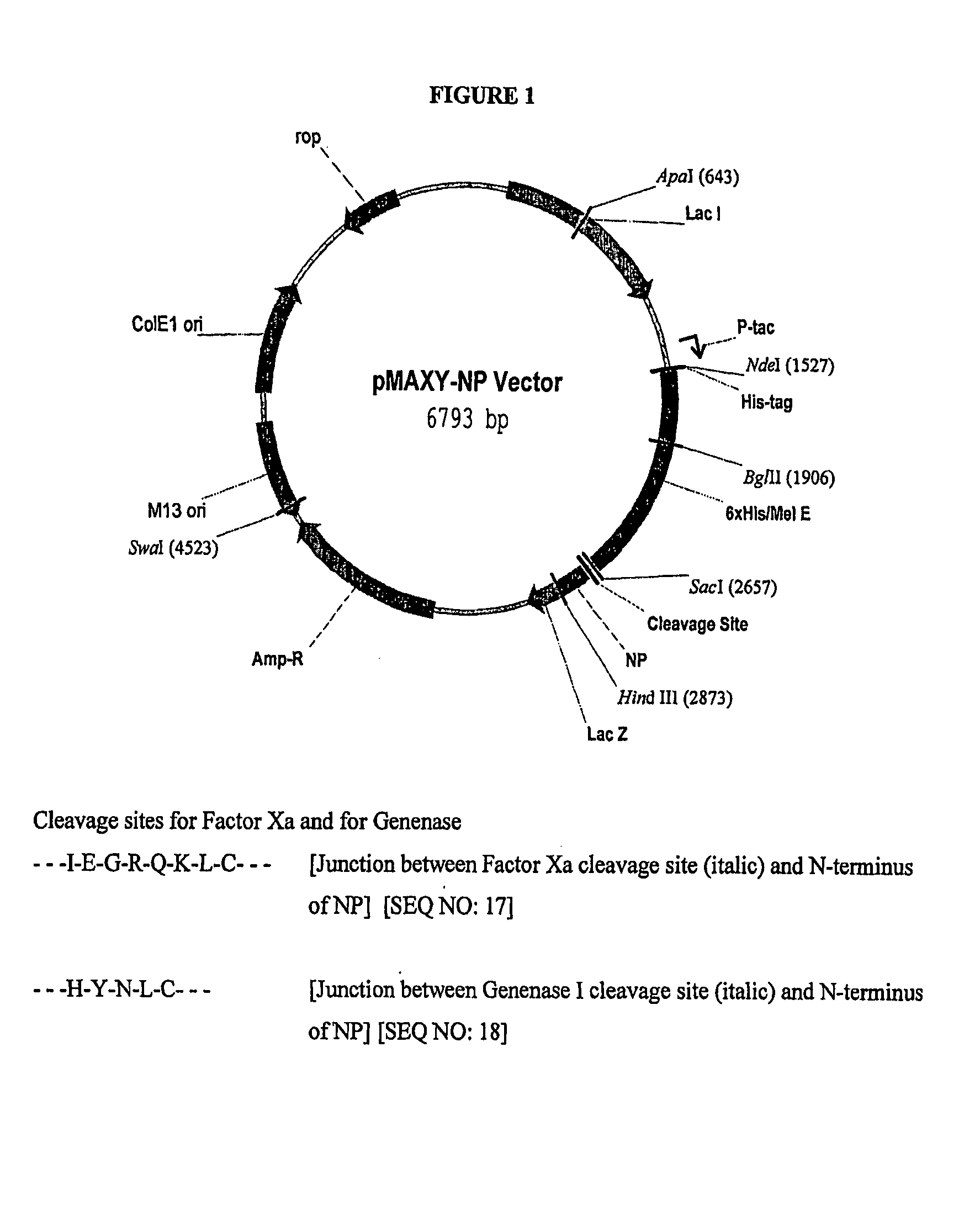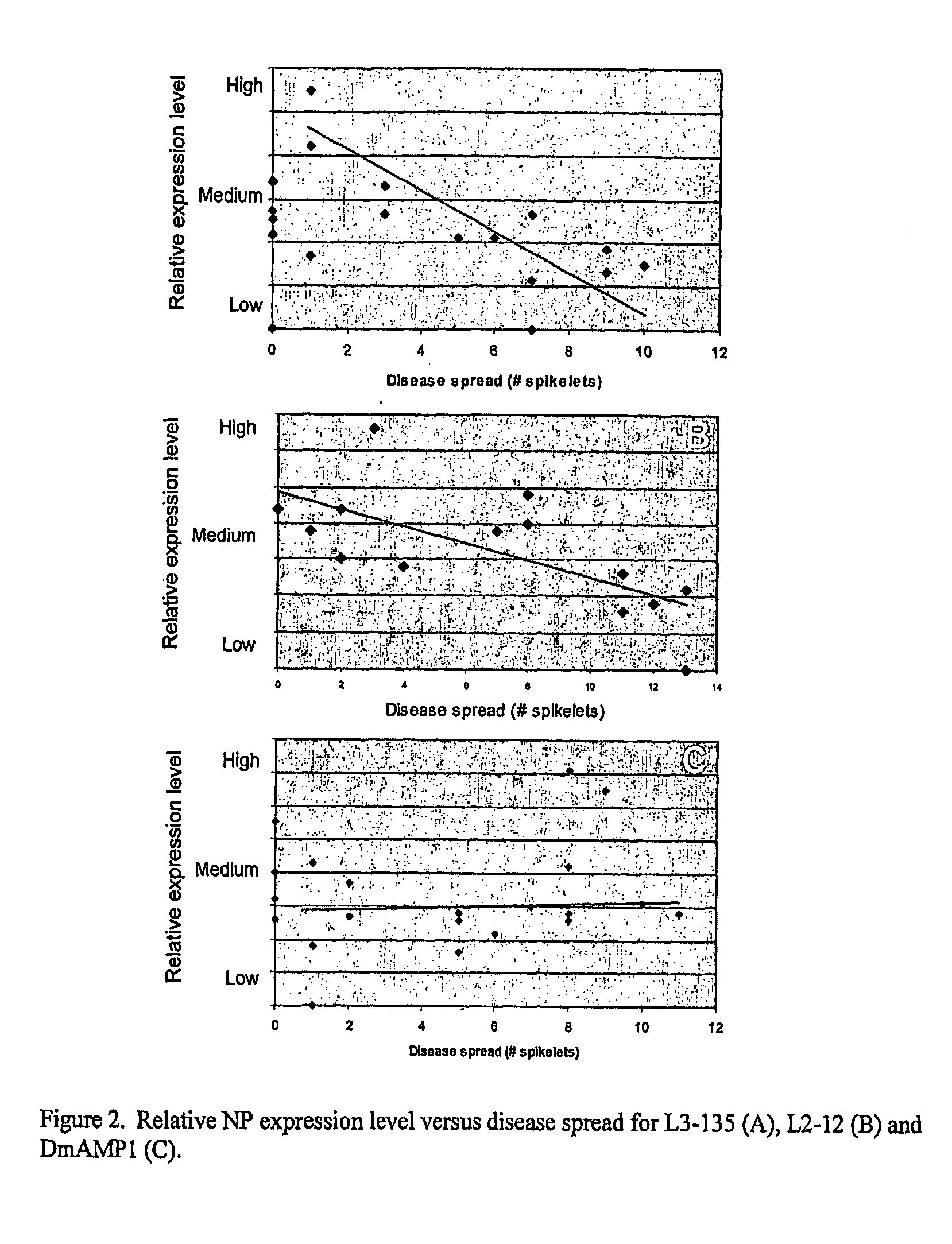Production of antimicrobial proteins in fusion proteins
a technology of fusion proteins and proteins, applied in the field of antifungal agents, can solve the problems of insufficient resistance to attack on commercially valuable plants, and the number of commercially valuable plants, including common agricultural crops, are susceptible to attack
- Summary
- Abstract
- Description
- Claims
- Application Information
AI Technical Summary
Benefits of technology
Problems solved by technology
Method used
Image
Examples
example ii
5.2 Example II
Antifungal Activity Assay and Results
[0171]Pathogens Fusarium graminearum and Septoria tritici were cultured on potato dextrose agar or V8 agar at 25° C. The antifungal activity assay of NP polypeptides and defensins was done as described by Terras et al., 1992, J. Biological Chemistry 267:15301-309, with modifications. Agar plates of the fungal culture were flooded with 2×SMF medium (SMF medium: 2.5 mM K2HPO4, 50 μM MgSO4, 5 μM FeSO4, 0.1 μM CoCl2, 0.1 μM CuSO4, 2 μM Na2MoO4, 0.5 μM H3BO3, 0.1 μM KI, 0.5 μM ZnSO4, 0.1 μM MnSO4, 1 mM CaCl2, 50 mM KCl, 20 g / l glucose, 2 g / l asparagine, 40 g / 1 methionine, 2 mg / l myo-inositol, 0.2 mg / l biotin, 1 mg / l thiamine-HCl, 0.2 mg / l pyridoxin-HCl). The suspension was filtered through 3 layers of sterile cheesecloth and then diluted to a concentration of 104 to 105 spores / ml. The fungal spores were germinated in a 96 well microtiter plate at 25° C. for 8 to 18 hours.
[0172]Wild-type defensin protein samples were mixed with an equal v...
example iii
5.3 Example III
Antifungal Activity Assay and Results Using HPLC-Purified NPs
[0173]Additional assays were conducted with HPLC-purified NPs. Recombinantly expressed NPs prepared as in Example I were purified by Ni-NTA agarose chromatography followed by RP-HPLC purification. The concentration of the HPLC-purified NP protein was determined by capillary electrophoresis (CE). CE was carried out on a 100 cm (91.5 cm effective length)×50 μm ID polyimide coated fused silica capillary (Composite Metal Services; Hallow, Worcestershire, UK) at 20° C. The electrolyte was aqueous di-sodium hydrogen orthophosphate (20 mM), containing CTAB (2 mM), adjusted to pH 6.5 with orthophosphoric acid. The capillary was flushed with electrolyte for 3 min between injections. Separations were performed at an applied voltage of 30 kV (negative polarity). Protein samples (2 mg mL−1) were prepared in de-ionized water. Injections were made hydrodynamically using a pressure of 50 mbar for 20 s. Detection was by UV ...
example iv
5.4 Example IV
Infiltration Assays for Antifungal Activity
[0176]This example describes an in vivo assay for antifungal activity or other antimicrobial activity. This assay, referred to as an “infiltration assay’ or ‘in planta assay’ is carried out by infiltrating NP protein (e.g., using a syringe, vacuum or via the vascular system of the plant) into a plant part. Typically, the concentration of NP introduced into the plant is similar to that the level of protein that would be expressed in a plant transgenic for the NP). The plant is then infected with a pathogen and the effect of the NP on resistance is determined. By way of illustration, the assay is described for use in wheat, although it will be apparent that the assay can be used in a variety of plants with modifications evident to the ordinarily skilled practitioner.
[0177]Wheat head in planta assay to assess antimicrobial activity
[0178]1. Harvest wheat head(s) from plants at the onset of anthesis (anthers visible in the center o...
PUM
| Property | Measurement | Unit |
|---|---|---|
| length | aaaaa | aaaaa |
| burst pressure | aaaaa | aaaaa |
| pH | aaaaa | aaaaa |
Abstract
Description
Claims
Application Information
 Login to View More
Login to View More - R&D
- Intellectual Property
- Life Sciences
- Materials
- Tech Scout
- Unparalleled Data Quality
- Higher Quality Content
- 60% Fewer Hallucinations
Browse by: Latest US Patents, China's latest patents, Technical Efficacy Thesaurus, Application Domain, Technology Topic, Popular Technical Reports.
© 2025 PatSnap. All rights reserved.Legal|Privacy policy|Modern Slavery Act Transparency Statement|Sitemap|About US| Contact US: help@patsnap.com


